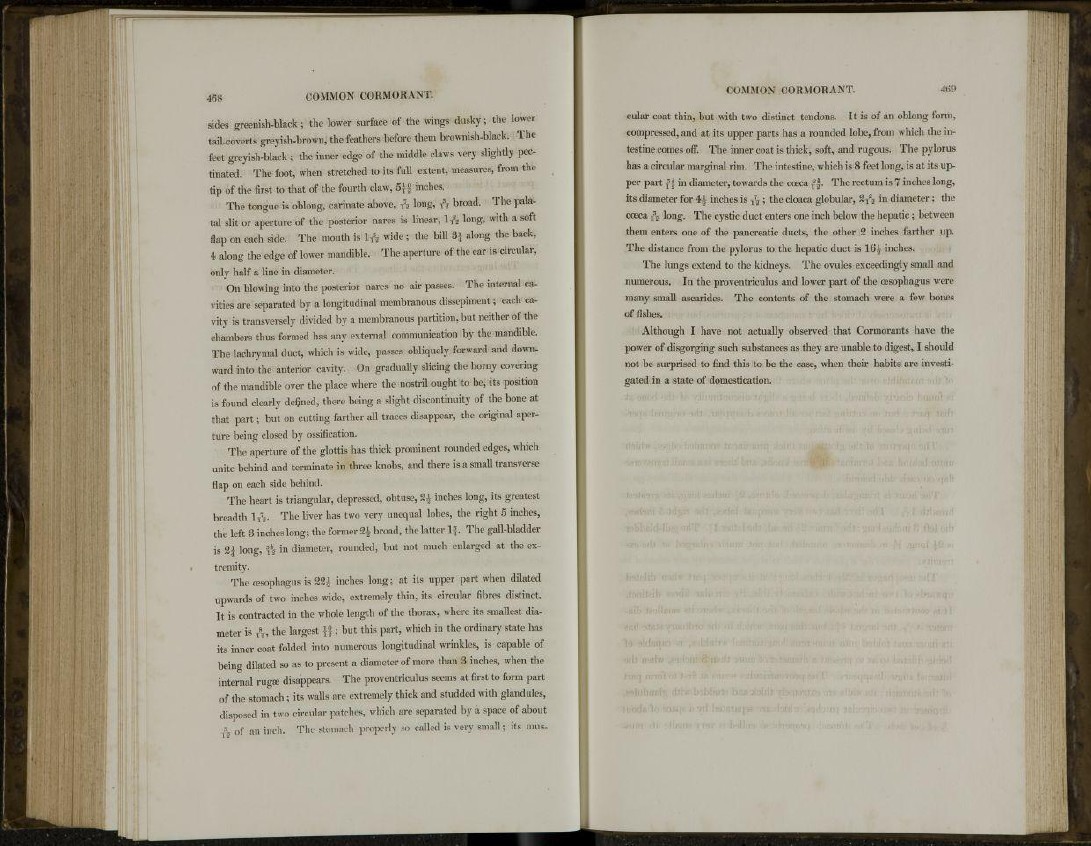
468 COMMON CORMORANT.
sides greenish-black ; the lower surface of the wings dusky; the lower
tail-coverts greyish-brown, the feathers before them brownish-black. The
feet greyish-black ; the inner edge of the middle claws very slightly pectinated.
The foot, when stretched to its full extent, measures, from the
tip of the first to that of the fourth claw, inches.
The tongue is oblong, carinate above, {'2 long, <fe broad. The palatal
slit or aperture of the posterior nares is linear, 1T
2
2 long, with a soft
flap on each side. The mouth is l^j wide; the bill 3A along the back,
4 along the edge of lower mandible. The aperture of the ear is circular,
only half a line in diameter.
On blowing into the posterior nares no air passes. The internal cavities
are separated by a longitudinal membranous dissepiment; each cavity
is transversely divided by a membranous partition, but neither of the
chambers thus formed has any external communication by the mandible.
The lachrymal duct, which is wide, passes obliquely forward and downward
into the anterior cavity. On gradually slicing the horny covering
of the mandible over the place where the nostril ought to be, its position
is found clearly defined, there being a slight discontinuity of the bone at
that part; but on cutting farther all traces disappear, the original aperture
being closed by ossification.
The aperture of the glottis has thick prominent rounded edges, which
unite behind and terminate in three knobs, and there is a small transverse
flap on each side behind.
The heart is triangular, depressed, obtuse, 2^ inches long, its greatest
breadth 1TV The liver has two very unequal lobes, the right 5 inches,
the left 3 inches long; the former 2£ broad, the latter If. The gall-bladder
is 2£ long, \% in diameter, rounded, but not much enlarged at the extremity.
The oesophagus is 22^ inches long; at its upper part when dilated
upwards of two inches wide, extremely thin, its circular fibres distinct.
It is contracted in the whole length of the thorax, where its smallest diameter
is T
8
S , the largest \% ; but this part, which in the ordinary state has
its inner coat folded into numerous longitudinal wrinkles, is capable of
being dilated so as to present a diameter of more than 3 inches, when the
internal ruga? disappears. The proventriculus seems at first to form part
of the stomach ; its walls are extremely thick and studded with glandules,
disposed in two circular patches, which are separated by a space of about
r
5
5 of an inch. The stomach properly so called is very small; its mus-
COMMON CORMORANT. 469
cular coat thin, but with two distinct tendons. It is of an oblong form,
compressed, and at its upper parts has a rounded lobe, from which the intestine
comes off. The inner coat is thick, soft, and rugous. The pylorus
has a circular marginal rim. The intestine, which is 8 feet long, is at its upper
part | | in diameter, towards the coeca |J. The rectum is 7 inches long,
its diameter for 4^ inches is ^ ; the cloaca globular, %j% in diameter ; the
cceca long. The cystic duct enters one inch below the hepatic; between
them enters one of the pancreatic ducts, the other 2 inches farther up.
The distance from the pylorus to the hepatic duct is 16^ inches.
The lungs extend to the kidneys. The ovules exceedingly small and
numerous. In the proventriculus and lower part of the oesophagus were
many small ascarides. The contents of the stomach were a few bones
of fishes.
Although I have not actually observed that Cormorants have the
power of disgorging such substances as they are unable to digest, I should
not be surprised to find this to be the case, when their habits are investigated
in a state of domestication.